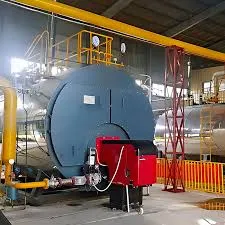
Feb . 07, 2025 04:03 Back to list
biomass fired steam boiler
Understanding the intricate world of steam boilers involves delving into their components and comprehending their functions. This comprehensive guide will walk you through the essential components of a steam boiler, offering insights into their roles and significance, based on years of specialized experience and rigorous technical expertise.
Safety Valves Safety is non-negotiable in steam boiler operations. Safety valves are designed to release pressure if it exceeds safe limits, protecting equipment and personnel from dangerous pressure levels that could cause catastrophic failure. Regular maintenance and testing of these valves are essential to uphold trust and safety standards. Steam Drum In a water-tube boiler, the steam drum is a large cylindrical component located at the top of the boiler. It provides a space where saturated steam can rise from the water, separating steam from any water particles. Proper functioning of the steam drum ensures the delivery of high-quality steam for industrial processes. Superheater For applications requiring high temperature and dry steam, the superheater plays a pivotal role. It further heats the steam produced in the steam drum beyond its saturation point, thus increasing the energy content and efficiency of the steam. Economizer Installed in the exhaust path, the economizer uses residual heat from flue gases to preheat the feedwater entering the boiler, thereby reducing fuel consumption and improving overall efficiency. Its role is indispensable in enhancing the ecological and economical aspects of steam boiler operations. Deaerator This component is essential for removing dissolved gases such as oxygen and carbon dioxide from the feedwater, which if left untreated, could lead to corrosion and reduce the boiler’s lifespan. Accurate control and operation of the deaerator ensure longevity and reliability. In conclusion, mastering the components and functionalities of steam boilers highlights the complex yet coordinated nature of these systems. This understanding is crucial for both optimizing performance and ensuring safety in industrial applications. Each component, from the burner to the deaerator, plays a distinct and indispensable role, echoing the precision engineering and meticulous craftsmanship inherent in quality steam boilers. For industries reliant on steam boilers, investing time in understanding these systems pays dividends through enhanced efficiency, reliability, and safety—cornerstones in achieving operational excellence.


Safety Valves Safety is non-negotiable in steam boiler operations. Safety valves are designed to release pressure if it exceeds safe limits, protecting equipment and personnel from dangerous pressure levels that could cause catastrophic failure. Regular maintenance and testing of these valves are essential to uphold trust and safety standards. Steam Drum In a water-tube boiler, the steam drum is a large cylindrical component located at the top of the boiler. It provides a space where saturated steam can rise from the water, separating steam from any water particles. Proper functioning of the steam drum ensures the delivery of high-quality steam for industrial processes. Superheater For applications requiring high temperature and dry steam, the superheater plays a pivotal role. It further heats the steam produced in the steam drum beyond its saturation point, thus increasing the energy content and efficiency of the steam. Economizer Installed in the exhaust path, the economizer uses residual heat from flue gases to preheat the feedwater entering the boiler, thereby reducing fuel consumption and improving overall efficiency. Its role is indispensable in enhancing the ecological and economical aspects of steam boiler operations. Deaerator This component is essential for removing dissolved gases such as oxygen and carbon dioxide from the feedwater, which if left untreated, could lead to corrosion and reduce the boiler’s lifespan. Accurate control and operation of the deaerator ensure longevity and reliability. In conclusion, mastering the components and functionalities of steam boilers highlights the complex yet coordinated nature of these systems. This understanding is crucial for both optimizing performance and ensuring safety in industrial applications. Each component, from the burner to the deaerator, plays a distinct and indispensable role, echoing the precision engineering and meticulous craftsmanship inherent in quality steam boilers. For industries reliant on steam boilers, investing time in understanding these systems pays dividends through enhanced efficiency, reliability, and safety—cornerstones in achieving operational excellence.
Share
Latest News
-
Best Steam Boiler Design PDF Free Design Calculation & Diagram Downloads
NewsJun.10,2025
-
Hot Boiler Water Heater Efficient Heating Solutions for Home & Commercial Use
NewsJun.10,2025
-
Steam Boiler Safety Devices High-Quality Protection Valves
NewsJun.10,2025
-
Ultimate Steam Boiler Checklist for Safety & Efficiency
NewsJun.10,2025
-
Optimal Hot Water Boiler Temperature Setting Guide
NewsJun.10,2025
-
Effective Hot Water Boiler Chemical Treatment Protect & Maintain
NewsJun.09,2025
Related PRODUCTS
Copyright © 2025 HEBEI HONGZE BOILER MANUFACTURING CO., LTD. All Rights Reserved. Sitemap | Privacy Policy






















